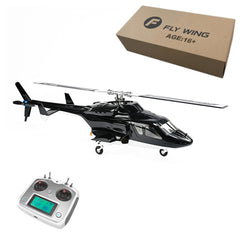Why Stability is Everything in RC Flight
- For Beginners: A stable helicopter is a forgiving one. It builds confidence, shortens the learning curve, and prevents costly crashes.
- For Advanced Pilots: Precision is built on a foundation of stability. It allows you to execute complex maneuvers like coordinated turns and precise hovering with trust and accuracy.
- For Aerial Photographers: Stability is non-negotiable. It's the difference between buttery-smooth, professional video and shaky, unusable footage.
Understanding H1 and ACE Flight Controllers: Key Differences
What is the H1-lite Flight Controller?

Introducing the H-ACE System

Head-to-Head Comparison
| H1-LITE scale | H-ACE scale | ||
| Airplane Mode | GPS Mode | √ | √ |
| Return-to-Home Mode | √ | √ | |
| Attitude Hold Mode (aircraft maintains a stable angle without full GPS lock) |
× | √ | |
| Manual Mode | √ | × | |
| Intelligent Stunt | × | × | |
| Functionality | One-Key Inverted Flight (instantly flips into upside-down flight) |
× | × |
| Stick-Controlled 3D Roll | × | × | |
| One-Key Figure-Eight / Circle Flight (automatic flight path in figure-eight or circle) |
√ | × | |
| Coordinated Turn | × | √ | |
| Smooth Takeoff | × | √ | |
| Smooth Landing | × | √ | |
| One-Key Control Sensitivity Switch (quickly toggles between control feel/sensitivity modes) | × | √ | |
| Usability | Compass Calibration Method | Requires PC Software Wired Calibration | Wireless Calibration |
| Built-in Multiple Aircraft Parameters | × | √ | |
| Safety | Low Battery Return-to-Home | √ | √ |
| Auto Return-to-Home on Lost RC Signal | √ | √ | |
| Pre-Flight Battery Charge Detection | × | √ | |
| Auxiliary Devices | ELRS Telemetry | × | √ |
| Navigation Light Control | × | √ | |
| Retractable Landing Gear | × | √ | |
| Hardware Structure | GPS Module | External | Internal |
| Servo Port | Standard Pin Header | Custom Gold-Plated Fool-Proof Connector | |
| Flight Log | × | √ |
Key Differences Explained:
- Stability Enhancements: The ACE controller introduces "Attitude Hold Mode," allowing the helicopter to maintain a stable angle even without a full GPS lock. This mode enhances flight stability, especially in unpredictable or low-signal environments. The H1 does not have this feature.
- Improved Usability: ACE offers wireless calibration and the ability to store multiple aircraft parameters, making it more versatile and user-friendly compared to the H1, which requires wired calibration and lacks multiple aircraft profiles.
- Flight Modes: The ACE system automates takeoffs and landings, eliminating the jerky liftoffs associated with the H1. The Coordinated Turn feature automatically banks the helicopter during turns, creating fluid, realistic movements.
Real-World Example: Upgrading Your FLYWING FW450 with ACE

- Stability During Flight: With ACE, the FW450 sees smoother and more responsive turns thanks to the "Coordinated Turn" feature, which is absent in the H1 system. The helicopter’s ability to perform stable, precise maneuvers, especially during more aggressive flying, is significantly improved.
- Easier Takeoffs and Landings: The "Smooth Takeoff" and "Smooth Landing" features make it easier to manage the helicopter during these critical flight phases. Whether you're a beginner or an experienced pilot, these features help reduce the risk of hard landings and crashes.
- Better Safety: The pre-flight battery charge detection and improved telemetry give pilots more confidence, knowing that the system will alert them if something goes wrong. In the event of low battery or loss of signal, ACE offers automatic return-to-home and upright recovery, ensuring that the FW450 remains safe.




